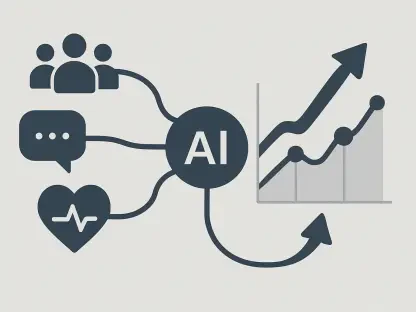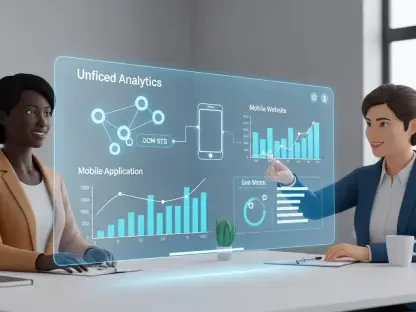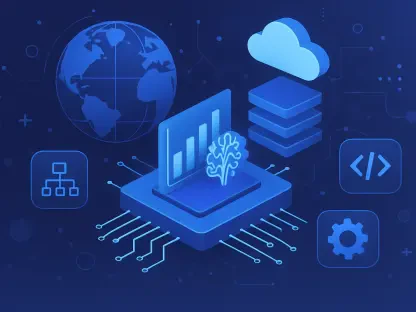As banks generate vast amounts of data daily, making sense of this information becomes increasingly challenging. Raw numerical data can be overwhelming and difficult to apply practically. Transforming this data into visual formats such as graphs and charts helps map out trends, anticipate risks, and aid decision-making. In the banking sector, data visualization is not merely a trend but a critical strategy for efficient data management and insightful decision-making.
The Importance of Data Visualization in Banking
Enhancing Decision-Making Processes
The conversion of complex datasets into simplified visual formats enables better decision-making. When comparing a traditional financial report filled with rows of data to a visually presented format, trends and insights are more easily identifiable. This simplification helps banks make informed decisions faster and with greater confidence. By turning raw data into intuitive visuals, bank executives and analysts can quickly pinpoint issues, spot opportunities, and understand trends that might otherwise go unnoticed. This rapid transformation from data to actionable intelligence means that decisions are made based on the most current and accurate information available.
Enhanced decision-making through visualization also plays a critical role in risk management. For instance, visual tools can immediately highlight areas of concern, such as an unusual spike in transactions or unexpected deviations in financial figures. This allows bank officials to act swiftly, averting potential issues before they escalate. Moreover, visualization aids in storytelling, providing a clear narrative that contextualizes data and makes it easier for stakeholders to comprehend complex scenarios. As banks increasingly rely on data to drive decisions, these visual tools bridge the gap between raw data and actionable insights.
Addressing Complex Data
Banks deal with enormous datasets that offer valuable insights when decoded correctly. Visualization tools break down these large datasets into manageable segments, allowing for more straightforward analysis and strategy formulation. Whether it’s tracking customer behavior, assessing market risks, or monitoring operational performance, visual data presentation is highly beneficial. By breaking down vast quantities of information into understandable visuals, banks can target specific areas for improvement or focus on strategic growth sectors. This granular level of detail is vital for making informed decisions that drive profitability and sustainability.
The true power of data visualization lies in its ability to uncover hidden patterns and correlations within complex datasets. Tools like Tableau, Power BI, and Qlik Sense enable banks to explore and analyze vast amounts of data interactively. These tools can rapidly process and display data from multiple sources, creating a cohesive and comprehensive view. This holistic perspective is crucial for spotting trends and anomalies that might otherwise be buried in vast numerical reports. In a sector where timely and accurate data interpretation is paramount, effective visualization tools become indispensable in driving strategic decisions and operational efficiency.
Tools for Data Visualization
Top Visualization Tools
Several sophisticated tools are aiding banks in their data visualization endeavors. Tableau is a popular choice for its interactive dashboards that highlight trends and patterns. Microsoft’s Power BI integrates seamlessly with other Microsoft products, offering comprehensive analytics. Qlik Sense is noted for its associative model, which reveals hidden connections in raw data. Each of these tools brings unique features and strengths, enabling banks to choose the one that best fits their specific needs and operational environments. As these tools evolve, they continue to offer more advanced functionalities that cater to the complex requirements of the banking industry.
Tableau’s powerful dashboards provide real-time insights into various aspects of banking operations, from financial performance to customer behavior. Its user-friendly interface and rich visualization options make it a favorite among data analysts. Power BI’s ability to integrate with existing Microsoft products like Excel and Azure adds a layer of convenience, enhancing productivity and streamlining workflows. Qlik Sense, with its ability to uncover hidden data relationships, offers deeper insights and more nuanced analysis, making it ideal for diving into complex datasets. Combined, these tools not only enhance data visualization capabilities but also improve overall data management and analytics processes.
Features and Benefits
Each tool brings unique features to the table. Tableau’s powerful dashboards provide real-time insights, while Power BI’s seamless integration boosts efficiency. Qlik Sense’s ability to uncover hidden data relationships allows deeper insights. These tools collectively help banks stay competitive and data-driven. For example, Tableau’s ability to handle vast amounts of data and produce high-quality visuals helps banks quickly identify trends and patterns that may not be immediately apparent in raw data. Power BI’s tight integration with Microsoft Office Suite means that employees can leverage existing software knowledge, reducing the learning curve and increasing adoption rates.
Qlik Sense stands out with its associative data model, which allows users to explore data freely, uncovering hidden insights and relationships. This flexibility is essential in the fast-paced world of banking, where timely and accurate data interpretation can mean the difference between success and failure. Additionally, these tools offer scalability, ensuring they can grow with the bank as its data needs evolve. Their ability to integrate with existing systems and processes means they can be seamlessly incorporated into current workflows, enhancing efficiency and productivity. Overall, the combination of these features ensures that banks are well-equipped to harness the power of data visualization to drive smart, data-informed decisions.
Applications of Data Visualization in Banking
Dashboards for Real-Time Monitoring
One of the primary uses of data visualization in banking is the creation of dashboards. These dashboards offer a consolidated view of key performance indicators (KPIs), which can be tracked in real-time. For example, risk management dashboards help evaluate credit risks and detect fraud more efficiently, contributing to smoother banking operations. By consolidating various metrics into a single, easy-to-understand visual display, dashboards provide an at-a-glance overview of the bank’s performance and risk landscape. This real-time monitoring is crucial in a sector where the ability to react swiftly to emerging trends and issues can significantly impact a bank’s success.
Dashboards also enhance transparency and accountability. By providing a clear and concise visual representation of KPIs, they enable senior management to make informed decisions quickly. This immediate access to critical data supports proactive management and strategic planning. Moreover, the interactive nature of modern dashboards allows users to drill down into specific metrics, uncovering insights and trends at a granular level. This depth of analysis ensures that potential issues are detected early and addressed promptly. As banking operations become more complex, the ability to monitor performance in real-time will increasingly be a differentiator in the industry.
Heat Maps for Behavioral Analysis
Heat maps are another valuable visualization tool, useful for identifying areas of concern or popularity within banking products. They are particularly effective in fraud detection and customer behavior analysis, offering a visual depiction of data that pinpoints trends and anomalies swiftly. By representing data density with colors, heat maps make it easy to see where activity is concentrated and where there might be unusual patterns. For instance, a heat map can quickly highlight regions or products with an unexpected spike in transactions, prompting further investigation by the bank’s fraud detection team.
In addition to fraud detection, heat maps are invaluable for understanding customer behavior. By visualizing customer interactions and transactions, banks can identify trends and preferences, allowing for more targeted marketing campaigns and improved customer service. For example, a heat map might reveal that mobile banking services are more popular in certain regions, prompting the bank to allocate more resources to enhance these services in those areas. This targeted approach not only improves customer satisfaction but also maximizes the return on investment for marketing and development efforts. The ability to swiftly interpret and act on these visual insights is a significant advantage in the competitive banking industry.
Real-Time Analytics for Dynamic Decisions
Real-time analytics are crucial in an industry where rapid decision-making can make a significant difference. By dynamically mapping data, banks can make real-time decisions regarding trades and transactions, ensuring they are always one step ahead in the fast-paced financial landscape. This capability is particularly important in trading environments, where market conditions can change in an instant. Real-time data visualization tools allow traders to see up-to-the-minute trends and shifts, enabling them to make informed decisions at a moment’s notice. This immediacy can translate directly into financial gains or losses, underscoring the importance of real-time analytics.
Real-time analytics also enhance customer service and operational efficiency. For instance, banks can use real-time data to monitor customer transactions and flag any unusual activity immediately. This proactive approach to fraud detection helps protect customers and reduce potential losses. Furthermore, real-time data can inform customer interactions, allowing bank representatives to provide timely advice and personalized services. For example, if a customer calls in with a query, the representative can quickly access real-time data about the customer’s recent transactions and account activities, providing accurate and relevant information. This level of responsiveness not only enhances the customer’s experience but also strengthens the trust and relationship between the bank and its clients.
Predictive Analytics in Banking
Forecasting Future Events
Predictive analytics, when combined with data visualization, can forecast future events based on past trends. In banking, this is invaluable for determining a customer’s likelihood of defaulting on a loan or predicting market fluctuations, allowing banks to mitigate risks proactively. By analyzing historical data and identifying patterns, predictive models can estimate future outcomes with a degree of accuracy that would be impossible with manual analysis. This foresight enables banks to make strategic decisions that reduce risk and capitalize on emerging opportunities. For instance, by predicting which customers are likely to default on loans, banks can take preventive measures to manage their risk exposure.
Predictive analytics is also instrumental in customer relationship management. By forecasting customer behavior, banks can tailor their services to meet individual needs and preferences. This personalized approach not only improves customer satisfaction but also enhances loyalty and retention. For example, predictive models can identify customers who are likely to be interested in new financial products, allowing banks to target their marketing efforts more effectively. This strategic use of data not only drives revenue growth but also ensures that resources are allocated efficiently. As predictive analytics continues to evolve, its applications in banking will only expand, providing even greater insights and opportunities.
Impact on Risk Management
Predictive analytics have shown to improve risk management outcomes significantly. A report by Ernst & Young notes that 78% of financial institutions using these analytics have seen better results in managing risks, underlining the efficacy of integrating predictive tools with data visualization practices. By leveraging these analytics, banks can identify potential risks before they materialize, allowing them to take preemptive action. This proactive approach not only minimizes potential losses but also enhances overall financial stability. For example, predictive models can forecast economic downturns or market volatility, enabling banks to adjust their strategies accordingly and safeguard their investments.
Moreover, predictive analytics enhances compliance and regulatory adherence. Financial institutions operate in a highly regulated environment, and non-compliance can result in severe penalties. Predictive models can help banks stay ahead of regulatory changes by identifying areas of potential non-compliance and suggesting corrective actions. This forward-thinking approach ensures that banks maintain their regulatory standing and avoid costly fines. The integration of predictive analytics into risk management frameworks thus represents a significant advancement in how banks approach risk. By providing a clear and actionable view of future risks, these tools enable banks to navigate an increasingly complex financial landscape with greater confidence and agility.
Industry Impact and Future Prospects
Industry Adoption and Investment
The banking sector is increasingly investing in AI-enhanced data analytics and visualization. According to a KPMG survey, 67% of banks plan to increase their investment in these technologies within the next two years. This move highlights the industry’s recognition of the transformative potential of data visualization tools. As data continues to grow in volume and complexity, banks are seeking advanced solutions to manage and interpret this information effectively. AI and data visualization technologies offer the tools needed to turn vast amounts of data into actionable insights, driving smarter decisions and enhancing operational efficiency.
This trend towards increased investment is also driven by the competitive pressures within the financial sector. Banks that leverage data visualization and analytics can gain a significant edge over their competitors. By offering more informed decisions and personalized customer experiences, these banks are better positioned to attract and retain clients. Additionally, the ability to quickly adapt to market changes and regulatory requirements ensures that they remain compliant and resilient. As a result, the adoption of AI-enhanced data analytics is not just a strategic choice but a necessity for staying relevant and competitive in the modern banking landscape.
Competitiveness Through Analytics
Deloitte’s report reveals that 80% of banking executives consider data analytics and visualization crucial for maintaining a competitive edge. This widespread belief underscores the urgency for banks to adopt these technologies to stay ahead in the competitive financial landscape. By harnessing the power of data analytics, banks can gain deeper insights into market trends, customer behavior, and operational performance. These insights enable them to make more informed and strategic decisions, driving growth and profitability. For example, data analytics can reveal emerging market opportunities, allowing banks to capitalize on new revenue streams.
The competitive advantage gained through data analytics and visualization also extends to risk management and regulatory compliance. By providing a clearer and more detailed view of potential risks, these tools enable banks to implement more effective risk mitigation strategies. This proactive approach not only safeguards financial stability but also enhances the bank’s reputation and trustworthiness. Furthermore, the ability to quickly analyze and respond to regulatory changes ensures that banks remain compliant and avoid costly penalties. As the financial industry continues to evolve, the integration of data analytics and visualization into all aspects of banking operations will be essential for maintaining competitiveness and achieving long-term success.
Emerging Technologies
Banks handle an immense amount of data every day, making it increasingly difficult to decipher and utilize effectively. Raw numerical data can be overwhelming and impractical to apply. Converting this data into visual formats like graphs and charts can map out trends, foresee risks, and support decision-making processes. In the banking industry, data visualization is not just a passing trend but a vital strategy for managing data efficiently and making informed decisions. By employing visual tools, banks can pinpoint critical insights, enhance accuracy in analyses, and improve their strategic planning. It’s a method that transforms complex data sets into comprehensible, actionable intelligence, facilitating clarity and operational efficiency. Data visualization not only aids in identifying patterns but also fosters timely responses to emerging risks, ensuring better compliance and customer satisfaction. As a crucial part of the financial sector’s toolkit, visual data representation helps banks navigate vast data landscapes, making sense of intricate information and converting it into practical, strategic actions for sustained success.









